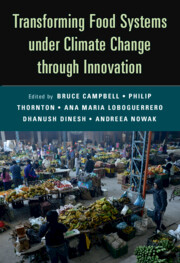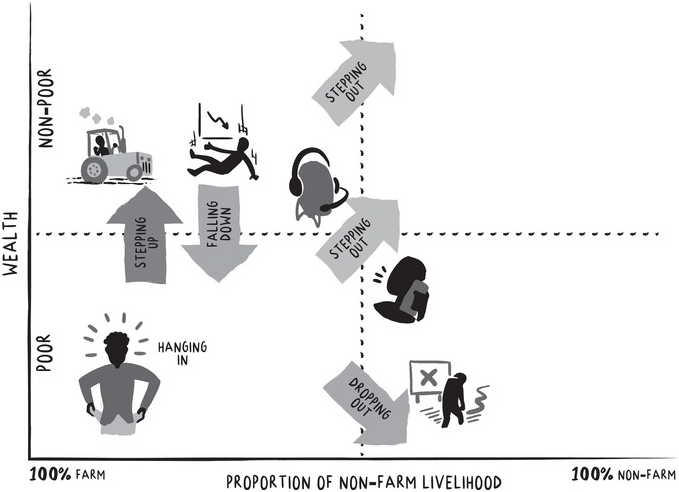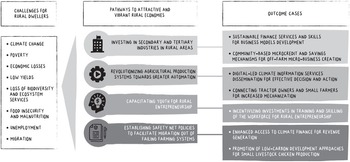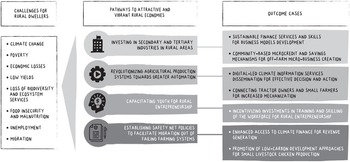Highlights
Rerouting farming and rural livelihoods to new trajectories is urgently needed in the context of increasing youth unemployment and failing food systems.
While agriculture must be made more attractive by promoting ‘stepping up’, alternative livelihoods based on allied economic sectors must be considered for ‘stepping out’. This option includes exits from agriculture.
Actions can be taken to bring about improved access to adequate financial services and skills, greater automation and better tools for more efficient development of agricultural activities, investments in training and re-skilling of the workforce for rural dwellers to engage in agribusinesses, and safety-net programmes to prevent ‘falling down’ and ‘dropping out’.
These actions must be inclusive of both women left behind in farming, and next-generation youths who are increasingly disenfranchised in rural areas and prone to migration.
6.1 Introduction
Poverty is particularly rural in the developing world, with two-thirds of those affected being youths. There is a sense of ‘doom and gloom’ around agriculture-centred livelihoods, and business-as-usual agriculture may not be an option in the future (Steiner et al., Reference Steiner, Aguilar and Bomba2020; Stringer et al., Reference Stringer, Fraser and Harris2020). According to IFAD (2019), agriculture-linked sectors alleviate the most poverty in rural areas, with youths and women central to rural development and food system transformation. Two-thirds of youths in developing economies live in areas with agricultural potential, which represents a considerable source of employment for jobless youths. Yet trends indicate that many young people are migrating in search of better economic opportunities. The structural weakness and limited diversification of these economies limit job creation and the absorption of the growing number of young entrants into the labour market. Indeed, marginalised farmers, youths, and women alike all face major challenges including inadequate access to information, education, and financial services; constrained access to markets; and suboptimal involvement in policy processes. A reinvigorated rural economy can spur agriculture to shift from being a direct, often subsistence, employer to a driver of rural development and growth (Steiner et al., Reference Steiner, Aguilar and Bomba2020). The challenge is to create attractive rural livelihoods, in or out of agriculture, and to build skill levels and opportunities to ensure that large numbers of people in rural areas move out of poverty.
While agriculture is the sole livelihood activity of some farmers, others maintain highly diversified livelihoods, including beyond the agricultural sector, particularly where returns from agriculture are insufficient to survive (Dhanush et al., Reference Dinesh, Loboguerrero Rodríguez and Millan2018). Hansen et al. (2018) proposed a typology for targeting resilience-building rural development interventions in the context of risk and poverty traps (Figure 6.1). The term ‘stepping up’ describes the situation of escaping poverty through changes to current farming activities, while ‘stepping out’ describes the process of escaping poverty by increasing incomes and assets through off-farm income opportunities or an exit from agriculture. ‘Hanging in’ describes the situation for farmers who are trapped in poverty, who seek to preserve their current meagre levels of welfare and assets in the face of stresses and shocks. Farmers who are ‘stepping up’ may ‘fall down’ into worsening poverty, and farmers who are ‘hanging in’ may ‘drop out’ of farming into a deeper, more intractable state of destitution. Therefore, the goal is rerouting farming and rural livelihoods to new trajectories that enable farmers to ‘step up’ or ‘step out’.
This chapter will discuss alternative livelihoods within agriculture through value addition and diversification into allied economic sectors. It will demonstrate how to build attractive rural livelihoods, including exits from agriculture where necessary. Steiner et al. (Reference Steiner, Aguilar and Bomba2020) suggest that to foster transformation, we need to create 20 million rural jobs by 2030 by investing in infrastructure and youths. Below, we build on four mechanisms to transform food systems under climate change as defined by Steiner et al. (Reference Steiner, Aguilar and Bomba2020), namely investing in secondary and tertiary industries in rural areas, that is, in opportunities for ‘stepping out’; revolutionising agricultural production systems towards greater automation, as part of ‘stepping up’; empowering the youth; and establishing safety-net policies and programmes (Figure 6.2).
6.2 Investing in Secondary and Tertiary Industries in Rural Areas
Currently, limited employment opportunities exist outside of agriculture in many remote rural areas. This situation can change, however, if in order to diversify rural economies beyond their reliance on agriculture, policymakers at national and local levels co-develop shared visions of the future (Chapter 14) and identify the policies required to develop appropriate secondary and tertiary industries (Steiner et al., Reference Steiner, Aguilar and Bomba2020). Effective secondary and tertiary services in rural areas will enable job creation and employment opportunities beyond agriculture, improve livelihoods and food security, generate inclusive growth, reduce poverty, and help build stronger, more stable rural economies.
An example of actions to build rural enterprises comes from the Nyando Basin, western Kenya, where environmental degradation and climate-change-induced threats are acute (Musyimi, Reference Musyimi2020). Climate-smart agriculture (CSA) practices offer opportunities to address these challenges yet require access to adequate financial services and skills. In Nyando, one of the main barriers to upscaling CSA has been the constrained access to credit and savings. One initiative provided tailored financial products and services combined with competence building to support smallholder farmers in their efforts to invest in and set up CSA-based small and medium-sized enterprises and businesses. With small farm sizes and a subsistence orientation, opportunities for commercial business models and investment portfolios are few. Inclusive financial markets and services provide affordable and equitable access to financial products and services to rural people, including agricultural and non-agricultural entrepreneurs, and particularly the most marginalised and vulnerable (Corrado & Corrado, Reference Carleton2017). These services can scale up CSA and build rural livelihood resilience (Oostendorp et al., Reference Oostendorp, van Asseldonk and Gathiaka2019). Two business models for CSA scaling were co-created through partnerships in the value chain (Wattel et al., Reference Wattel, Gathiaka and Mulwa2021). Increases in smallholder farmer finance were made possible by linkages between banks and community savings groups, as well as through farmers’ access to marketing contracts with off-takers (Wattel et al., Reference Wattel, Gathiaka and Mulwa2021). A key output of the co-creation process was awareness raising and motivation among farmers and community-based organisations about alternative viable economic options. The stakeholders came to understand the new business models that could prosper in the drought-prone, micro-scale farming conditions of Nyando. As a result, about 3,525 households in Nyando are currently involved in the community saving and loans groups and benefit from credits. This scheme has been scaled to reach 2,700 households in Hoima in Uganda and 1,980 households in Lushoto in Tanzania, both of which are classed as climate-smart villages (Ogada et al., Reference Ogada, Radeny and Recha2021).
Other examples include the village-based microcredit and savings associations for building rural household resilience in drought- and salinity-prone areas of Cambodia (IIRI & CEDAC, 2019). In the context of climate-induced vulnerability, the risks of smallholder-based agricultural production have been mitigated through village development fund and savings groups (VDFSG). These are non-agricultural entities that create various off-farm micro-businesses. Members of the VDFSGs, half of whom are women and youths, have benefited from savings and local credit services (Box 6.1). The examples above show how investing in sustainable financing mechanisms can help farmers improve their climate-risk resilience and move from ‘hanging in’ to ‘stepping out’.
Box 6.1 Creating Rural Jobs through Climate-Smart Agriculture Micro-Businesses in Cambodia
Members of a VDFSG deposit their cash savings on a monthly basis, then borrow money from the VDFSG to start micro-businesses to replace their lost jobs. These micro-enterprises mostly consist of small livestock production, intensive drip-irrigation-based vegetable gardens, homestead-based fruit agroforestry, and non-agricultural businesses. Once a certain amount of money has been saved for CSA purposes, the VDFSG supplements these savings, increasing the accumulated total capital. This structure has contributed to building community ownership, where communities manage collective funds and reduce the possible risks in loan repayment. As of June 2021, 37 VDFSGs have been established in 37 villages in the target community-protection area and community forest areas of Koh Kong and Mondul Kiri, with a total of 1,969 members, 69 percent of whom are women. Loanable funds have reached US$851 387, wherein US$444 820 has come from members’ savings deposits, plus US$385 802 of Asia Development Bank funds. Additional funds are generated from the interest-based income from loans repaid by members. Women also benefited from the financial services of the VDFSGs.
6.3 Revolutionising Agricultural Production Systems towards Greater Automation
Many rural dwellers see agriculture as drudgery, requiring heavy labour commitments often in hot climates. A combination of a lack of knowledge and limited opportunities for farmers and cooperatives to access start-up capital prevents greater automation, particularly in the context of climate variability. Greater automation and tools for farmers’ decision-making will allow more efficient development of agricultural activities, by facilitating access to information, reducing labour time, and increasing productivity.
An example from Colombia shows how automation has transformed production systems, where innovative work is being done to provide climate information and help farmers make better-informed decisions. A digital agroclimatic forecast system was developed to provide highly automated climate services for agriculture. The Pronosticos AClimate Colombia system was used to first understand the demand for climate information, then leverage this understanding to produce tailored information to support crop-specific decision-making (Sotelo et al., Reference Sotelo, Guevara and Llanos-Herrera2020). The system was applied to two of Colombia’s most important staple crops, rice and maize, both highly affected by climate (Sotelo et al., Reference Sotelo, Guevara and Llanos-Herrera2020). It is an interface for translating and transferring forecasts generated by the Colombian meteorological service and disseminated through Local Technical Agroclimatic Committees. The system implements seasonal climate forecasts using methods in line with those used by the Colombian meteorological service and connects them with crop-simulation models. The result is actionable decision-making information concerning planting dates and the crop varieties that best suit forthcoming climatic conditions. As a web-based platform, the system facilitates direct access to general and context-specific climate information that can be understandable and useful to the farmers and different users.
In 2014, Fedearroz – the National Federation of Rice Growers – advised 170 rice farmers not to plant in the first of the two annual growing seasons based on the forecasts and recommendations of the AClimate Colombia system, avoiding a yield loss of 1–2 tonnes ha-1 and economic loss of US$1.7 million (CCAFS, 2015). The use of AClimate Colombia is increasing, and a recent ex-post impact assessment indicated that 9 154 farmers have used agroclimatic forecasts to manage their crops. More frequent use of agroclimatic forecasts has positively impacted yield and harvest losses (INSUCO et al., Reference Dinesh, Zougmore and Vervoort2020).
Another successful case to revitalise rural economies – through mechanisation and labour saving – comes from Hello Tractor Inc., an agri-tech company that connects tractor owners with smallholder farmers in Sub-Saharan Africa through a farm-equipment-sharing application (Hello Tractor, 2018). Headquartered in Abuja, Nigeria, Hello Tractor is active in Kenya, Mozambique, Senegal, and Tanzania. Many smallholder farmers in this region lack the capital to purchase machinery (Cabral & Amanor, Reference Cabral and Amanor2021). Through Hello Tractor they can rent one at a fraction of the cost and reduce their physical labour. Hello Tractor is now providing services to more than 500 000 farmers in Sub-Saharan Africa, facilitating mechanisation and increased productivity while generating new employment opportunities for digital entrepreneurs in rural areas. By integrating ground intelligence with mechanisation, Hello Tractor enables owners to grow their business and creates equitable access to tractor services; by doing so, the company enables smallholder farmers to both earn and grow more, improving income and food security for their families and communities (Hello Tractor, 2018). The company is creating efficiencies that generate inclusive growth, reduce poverty, and help build stronger, more stable economies (Hello Tractor, 2018).
6.4 Capacitating Youth for Rural Entrepreneurship
Many young people view agriculture as economically unrewarding work. Strengthening their capacity to invest energy into starting agribusinesses, however, can create both jobs and wealth. Incentivising investments in training and re-skilling of the workforce can allow producers and rural dwellers to engage in new activities such as agri-processing, distribution, and provision of farm inputs, as well as being infomediaries and service-providers through information and communication technologies.
The West Africa Agricultural Productivity Programme (WAAPP) is an initiative that contributed to rural entrepreneurship through youth capacity-strengthening (Ouedraogo et al., Reference Oostendorp, van Asseldonk and Gathiaka2019). One of WAAPP’s aims is to train the youth to adopt CSA innovations for small agri-preneurship (Box 6.2) (CORAF, 2018). Based on WAAPP’s success stories, the Economic Community of West Africa States (ECOWAS) decided to use this approach to run its youth employment strategy (ECOWAS, 2019). By 2022, an estimated US$300 000 will have been allocated to five centres of specialisation, to train at least 450 youths in technologies and innovations with high youth-employment potential. Indeed, 11 similar successful agri-preneurships were developed through this regional agricultural programme (CORAF, 2018).
Box 6.2 A Plantain Nursery Enterprise in Côte d’Ivoire
During 2018, the innovative Côte d’Ivoire agribusiness Canaan Agriculture Sarl had a turnover of close to USD$180 000 (CORAF, 2018). Canaan Agriculture Sarl is owned by a young Ivorian, Narcisse Aman, one of the nurserymen trained in producing plantain plants derived from stem fragmentation technology under WAAPP. Bananas and plantains are the fourth most important food crop in Côte d’Ivoire after yams, cassavas, and rice. Thanks to the training and the knowledge acquired, Aman started with three explants – the part of the plant from which a whole plant can be produced – from which he could develop seeds in the form of vivo-plants (CORAF, 2018). According to Aman, the WAAPP training was a defining moment for him. Today, Aman runs close to 60 operations across different locations in Côte d’Ivoire, with roughly 10 full-time employees and many more seasonal workers. For a company that started only a few years ago, this represents spectacular growth and speaks to the untapped potential of entrepreneurship in agriculture in Côte d’Ivoire and beyond.
6.5 Establishing Safety-Net Policies and Programmes
When farming is not viable, we need safety-net programmes to keep producers from ‘falling down’ and ‘dropping out’. Chapter 7 covers safety-net programmes in more detail and clearly explains that designing adaptive safety-net interventions requires the adoption of a holistic approach. This approach views agriculture as an integrated component of rural poverty reduction, urban food security, and inclusive economic growth, under natural-resource scarcity. Alternative programmes that facilitate households shifting to other parts of the food system beyond the farm can support the livelihoods of vulnerable populations. Policy and programmes can create jobs and encourage people to leave agriculture when necessary.
Carbon pricing – the generation of revenues to pursue economic and development objectives from reduced greenhouse gas emissions and carbon sequestration – is one financing mechanism that can help producers exit farming. For example, in collaboration with donors such as the Green Climate Fund and the African Development Bank, the West African Alliance on Carbon Markets and Climate Finance and the East African Alliance on Carbon Markets and Climate Finance are working to increase access to climate finance. Doing so will allow the scale-up of programmatic crediting approaches with high sustainable-development impacts, such as participatory land-conservation plans for biodiversity and ecosystem services (Gonzalez & Shelter, Reference Klein, Jochaud and Richter2021). The targeting of land for conservation purposes and the establishment of non-farm activities, as seen in Benin, are examples of how safety-net measures can shift producers away from farming (Box 6.3).
Box 6.3 Targeting Land for Conservation and Establishing Non-Farm Activities Around the Pendjari Region in Benin
The Pendjari National Park was established in northern Benin in 1954 during the colonial period, without the consent of local communities, who were evicted from their farming lands to make way for it. Farmers were also forbidden from farming near the Pendjari conservation area, and local park officials destroyed farms around the park every year (Klein at al., Reference Klein, Jochaud and Richter2013). Until 1992, the park was managed by the forest department in an oppressive manner, resulting in many clashes between the forest administration and local communities over resource use. After the Rio de Janeiro Summit in 1993, however, the participatory management of the Pendjari National Park began. According to the plan, local park officials were to allow sport-hunting of a limited number of animals annually (Klein at al., Reference Klein, Jochaud and Richter2013). The hunting fees paid by tourists aid in the coordination and agreement of community development plans by involving the local population in some reserve-management tasks. Hunting enables 130 people from the surrounding villages to work as trackers, gamekeepers, and tourist guides, which has strengthened the rural population’s awareness of the park’s importance, resulting in farming ceasing around the park.
Another successful example of safety-net creation can be seen in a Cambodian pilot project, which focuses on entrepreneurs adopting small-scale, climate-smart chicken production to improve local food systems. This initiative was created to promote low-carbon approaches for small-scale chicken production development, as a response to the climate-related risks of failing crop production (Manilay et al., Reference Manilay, Phen and Cabriole2021). In the provinces of Koh Kong and Mondulkiri, 39 households, two-thirds of which are led by women, have transformed their livelihoods through this initiative. Hatchery operators earned a total net income of US$10 136 and US$13 604 in 2019 and 2020, respectively, far more than the US$6,286 and US$8,003 sums for those without hatcheries (IIRR & CEDAC, 2020).
6.6 Way Forward
There is an urgent need for alternative economic livelihoods within agriculture through value addition and diversification across allied economic sectors. This chapter has analysed how innovative mechanisms can drive change and rural reinvigoration. These mechanisms include investing in secondary and tertiary industries in rural areas, revolutionising agricultural production systems towards greater automation, empowering the youth, and establishing safety-net policies. Implementing these mechanisms can reduce drudgery, broaden access to new tools that help farmers make more efficient decisions, and create enabling environments that encourage youths and women to participate in rural development. When given the right tools, youth and women can create successful rural businesses using agricultural technologies and innovations. Agriculture must be made attractive to the next generation as a sector with opportunities, not only in farming per se but also in a rural service economy. Agriculture must also be inclusive for both women left behind in farming and next-generation rural youths. This group is increasingly disenfranchised, making them prone to migration and conflicts. Where farming becomes unviable, safety-net policies and programmes can support these groups, including by shifting opportunity to other parts of the food system or out of agriculture entirely.





